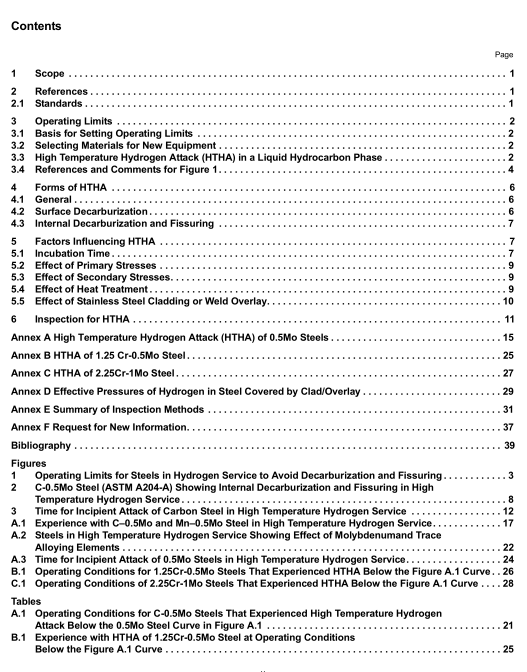API RP 941 pdf download

API RP 941 pdf download Steels for Hydrogen Service at Elevated Temperatures and Pressures in Petroleum Refineries and Petrochemical Plants
4 Forms of HTHA
4.1 General
High temperature hydrogen can attack steels in two ways:
a) surface decarburization, and
b) internal decarburization and fissuring.
The combination of high temperature and low hydrogen partial pressure favors surface decarburization without internal decarburization and fissuring. The combination of low temperature, but above 430°F (221°C), and high hydrogen partial pressure favors internal decarburization and fissuring, which can eventually lead to cracking. At high temperatures and high hydrogen partial pressures both mechanisms are active. These mechanisms are described more fully below. The broken-line curves at the top of Figure 1 represent the tendencies for surface decarburization of steels while they are in contact with hydrogen. The solid-line curves represent the tendencies for steels to decarburize internally with resultant fissuring and cracking created by methane formation.
4.2 Surface Decarburization Surface decarburization does not produce fissures. In this respect, it is similar to decarburization created by the exposure of steel to certain other gases, such as air, oxygen, or carbon dioxide. The usual effects of surface decarburization are a slight, localized reduction in strength and hardness and an increase in ductility. Because these effects are usually small, there is often much less concern with surface decarburization than there is with internal decarburization. A number of theories have been proposed to explain this surface decarburization [2], [3], [4], but the currently- accepted view is based on the migration of carbon to the surface where gaseous compounds of carbon are formed, rendering the steel less rich in carbon. The gaseous compounds formed are CH 4 or, when oxygen-containing gases are present, CO.
Water vapor hastens the reaction. Carbon in solution diffuses to the surface so that the rate- controlling mechanism appears to be carbon diffusion. Inasmuch as the carbon in solution is continuously supplied from the carbides, carbide stability is directly related to the rate of surface decarburization. In cases where surface decarburization predominates over internal attack, the actual values of pressure-temperature combinations have not been extensively studied; but the limits defined by Naumann [5] probably give the most accurate trends. Naumann’s work, which is based on 100-hour tests, indicates decarburization tendencies; however, long-time exposures have indicated lower operating limits.
4.3 Internal Decarburization and Fissuring The solid-line curves in Figure 1 define the areas above which material damage by internal decarburization and fissuring/cracking have been reported. Below and to the left of the curve for each alloy, satisfactory performance has been experienced with periods of exposure of up to approximately 50 years. At temperatures above and to the right of the solid curves, internal decarburization and fissuring/cracking occurs. Internal decarburization and fissuring are preceded by an incubation period that depends on temperature and hydrogen partial pressure (see 5.1 for further discussion). Internal decarburization and fissuring are caused by hydrogen permeating the steel and reacting with carbon to form methane [5]. The methane formed cannot diffuse out of the steel and typically accumulates at grain boundaries.
This results in high localized stresses which lead to the formation of fissures, cracks, or blisters in the steel. Fissures in hydrogen-damaged steel lead to a substantial deterioration of mechanical properties. Figure 2 shows the microstructure of a sample of C-0.5Mo steel damaged by internal decarburization and fissuring. The service conditions were 790°F (42°C) at a hydrogen partial pressure of 425 psia (2.9 MPa) for approximately 65,000 hours in a catalytic reformer. The addition of carbide stabilizers to steel reduces the tendency toward internal fissuring. Elements such as chromium, molybdenum, tungsten, vanadium, titanium, and niobium reduce the number of nucleation sites by forming more stable alloy carbides which resist breakdown by hydrogen and, therefore, decrease the propensity to form methane [6]. The solid-line curves in Figure 1 reflect the increased resistance to internal attack when molybdenum and chromium are present. The presence of nonmetallic inclusions tends to increase the extent of blistering damage. When steel contains segregated impurities, stringer-type inclusions or laminations, hydrogen or methane accumulations in these areas may cause severe blistering [7].
Alloys other than those shown in Figure 1 may also be suitable for resisting HTHA. These include modified carbon steels and low alloy steels to which carbide stabilizing elements (molybdenum, chromium, vanadium, titanium, or niobium) have been added. European alloys and heat-treating practices have been summarized by class [8]. Austenitic stainless steels are resistant to decarburization even at temperatures above 1000°F (538°C) [9]. Surface decarburization without fissuring has been associated with hydrogen partial pressure and temperature conditions that are not sever enough to generate the methane pressures needed to form fissures. This typically occurs where the Nelson curves become vertical [39].









